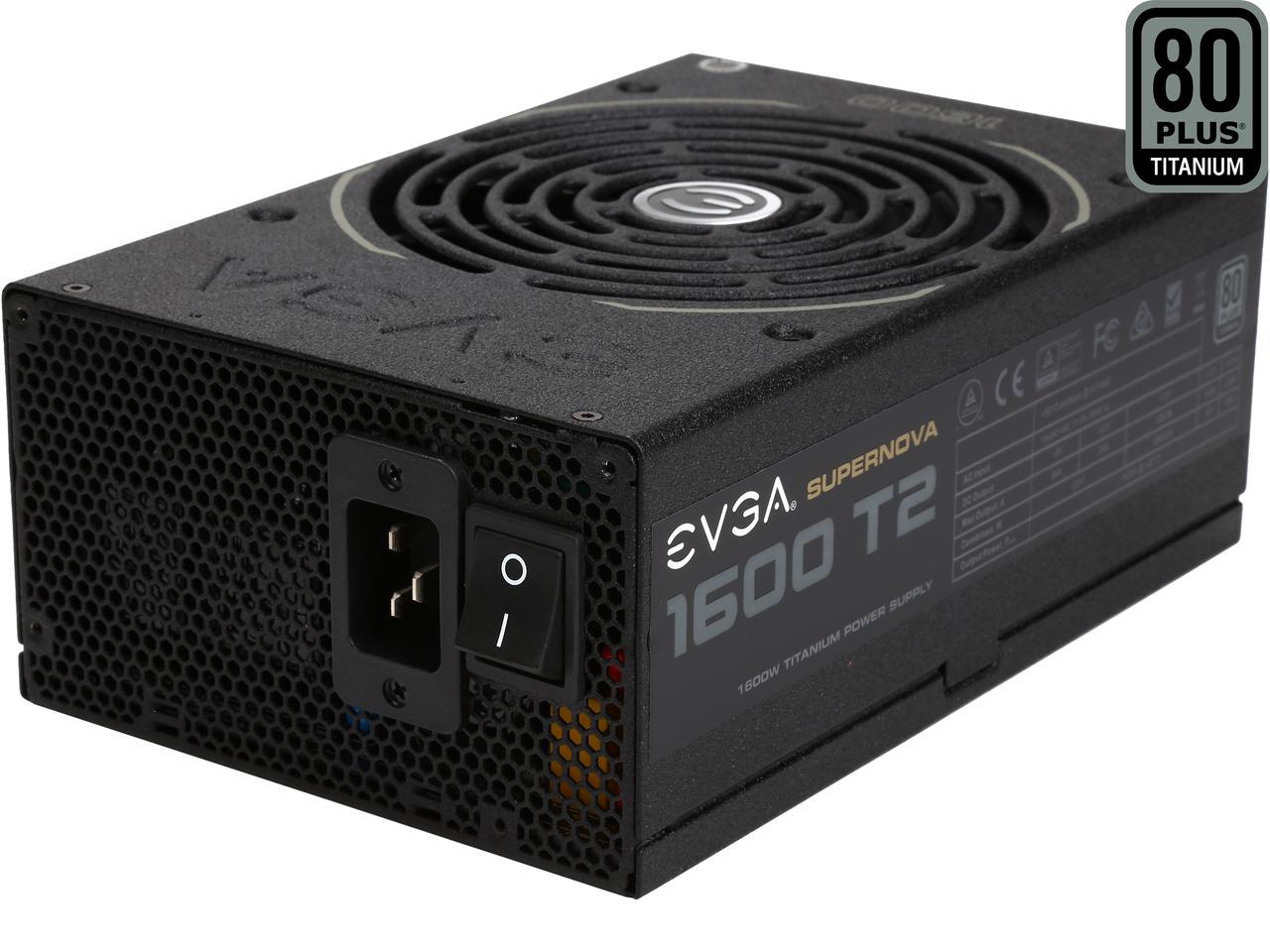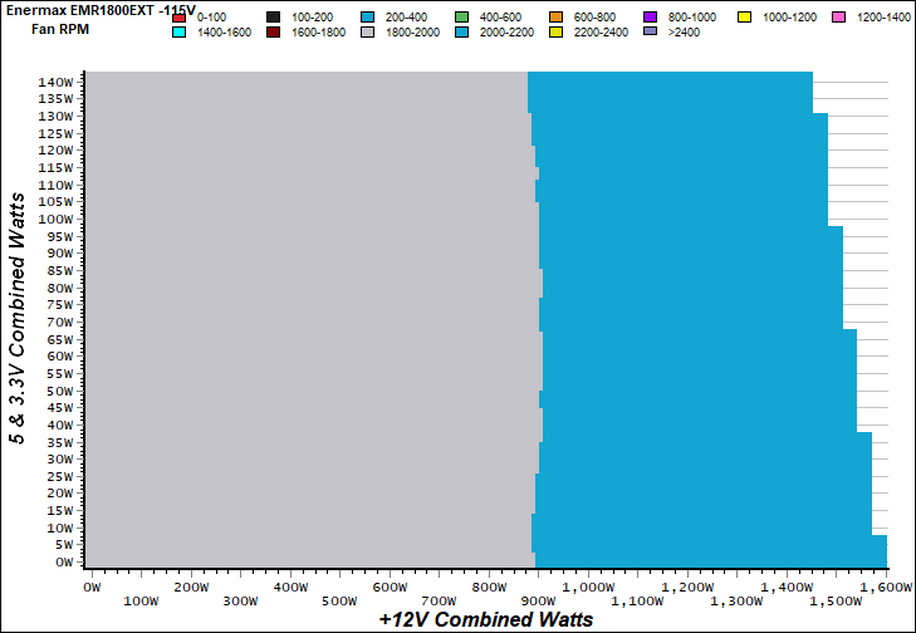Enermax MaxRevo 1800W Power Supply Review: Big Wattage and Noise to Match
Why you can trust Tom's Hardware
Load Regulation, Hold-Up Time, Inrush Current, Efficiency and Noise
To learn more about our PSU tests and methodology, please check out How We Test Power Supply Units.
Primary Rails And 5VSB Load Regulation
The following charts show the main rails' voltage values recorded between a range of 40W up to the PSU's maximum specified load, along with the deviation (in percent). Tight regulation is an important consideration every time we review a power supply, because it facilitates constant voltage levels despite varying loads. Tight load regulation also, among other factors, improves the system’s stability, especially under overclocked conditions and, at the same time, it applies less stress to the DC-DC converters that many system components utilize.
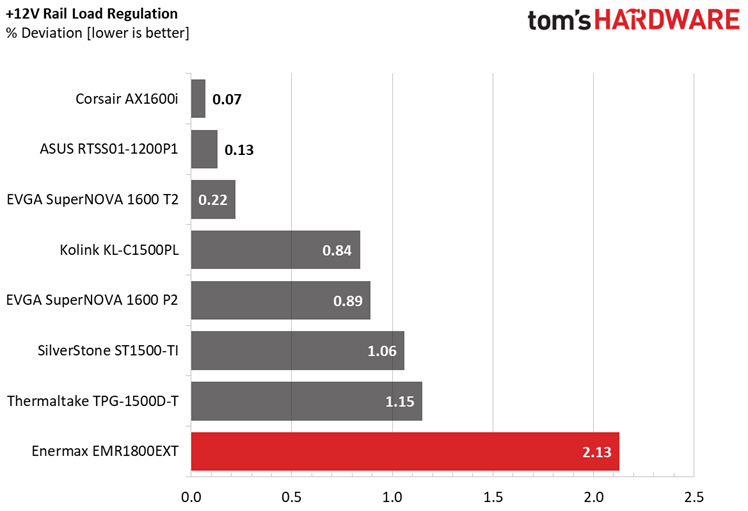
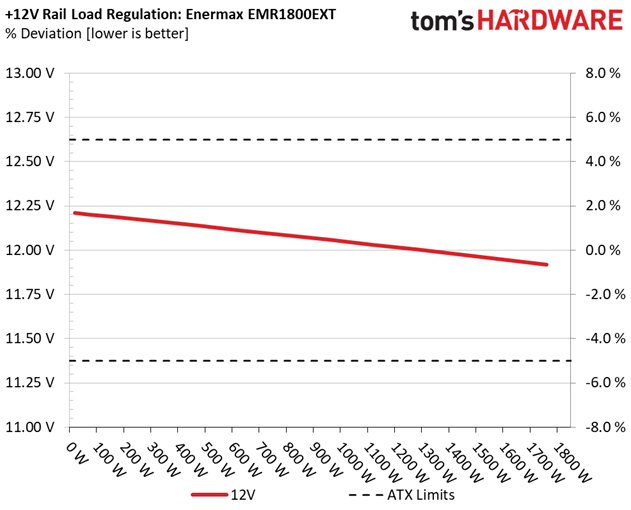
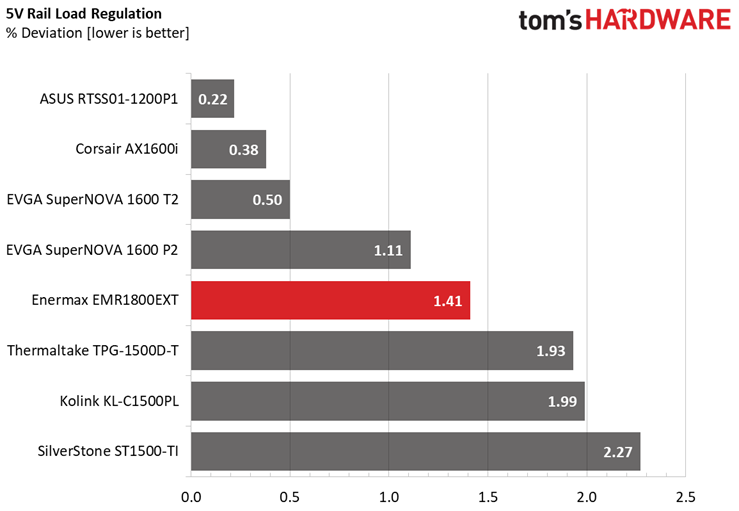

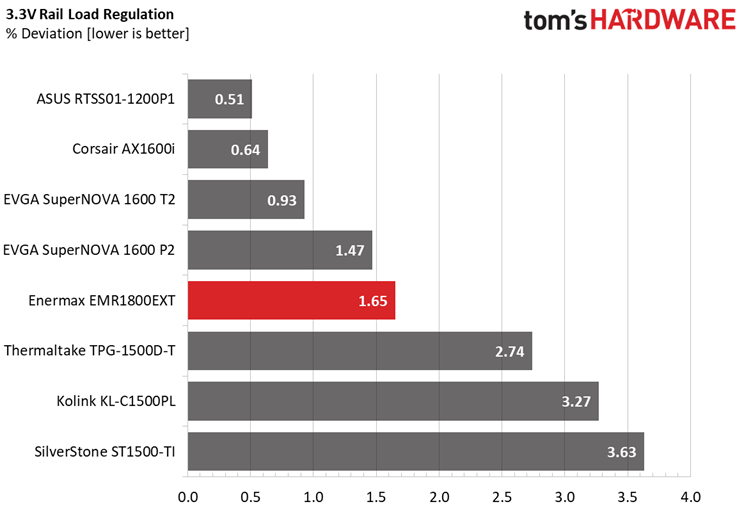
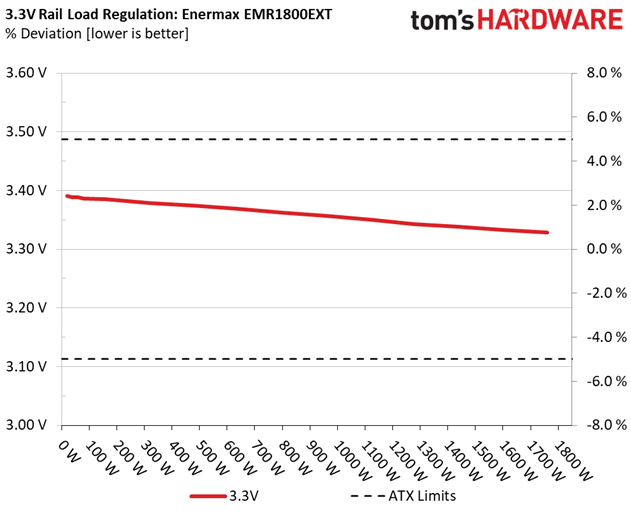

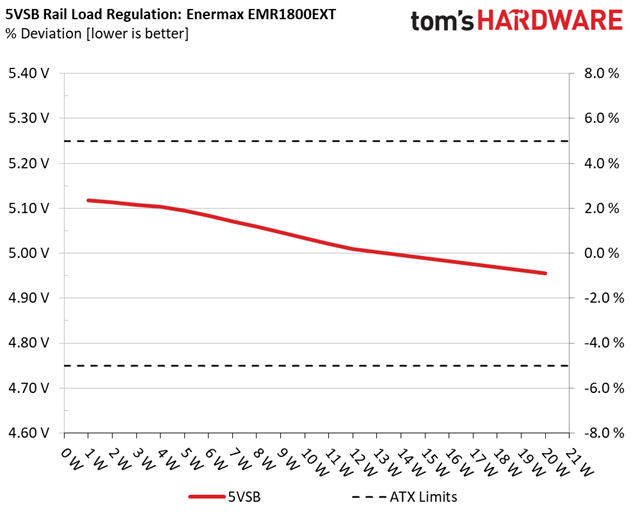
The load regulation at +12V, which is the most important rail, is anything but tight. On the 5V and 3.3V rails it is just satisfactory.
Hold-Up Time
Put simply, hold-up time is the amount of time that the system can continue to run without shutting down or rebooting during a power interruption.
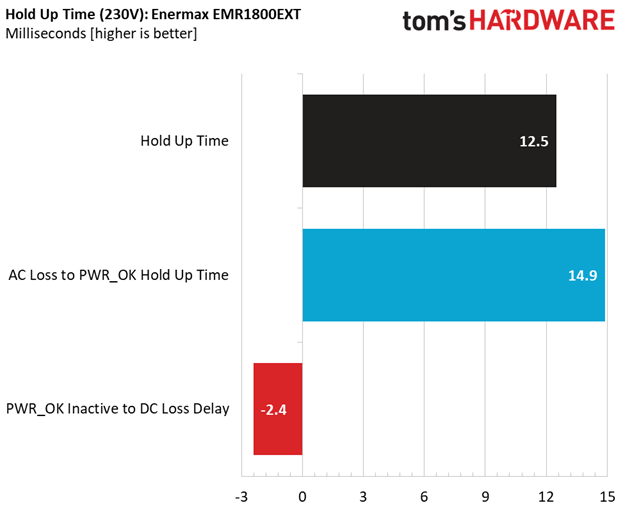
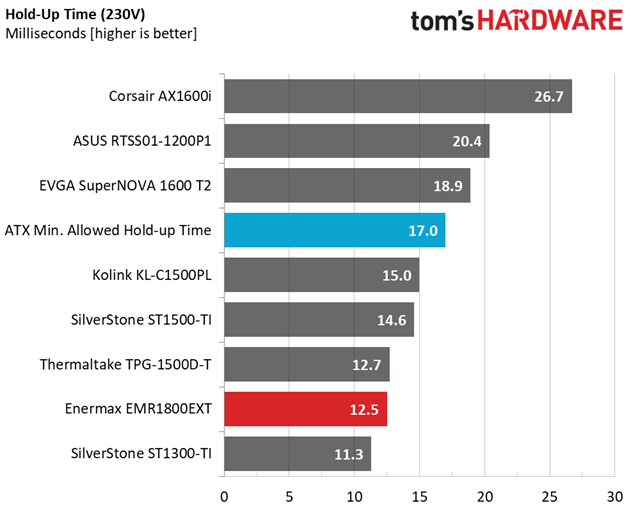
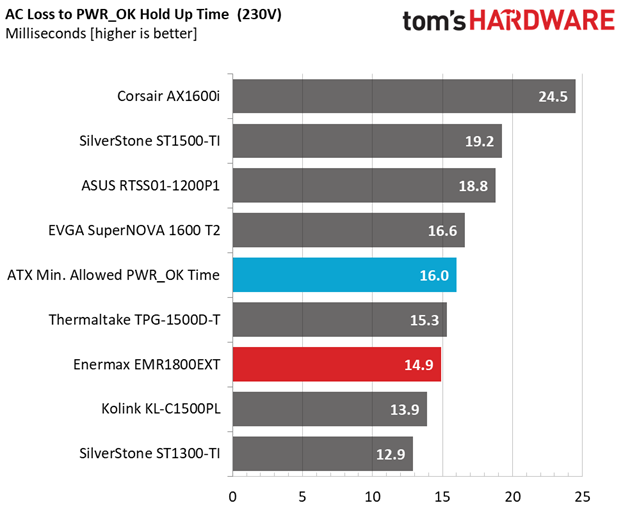
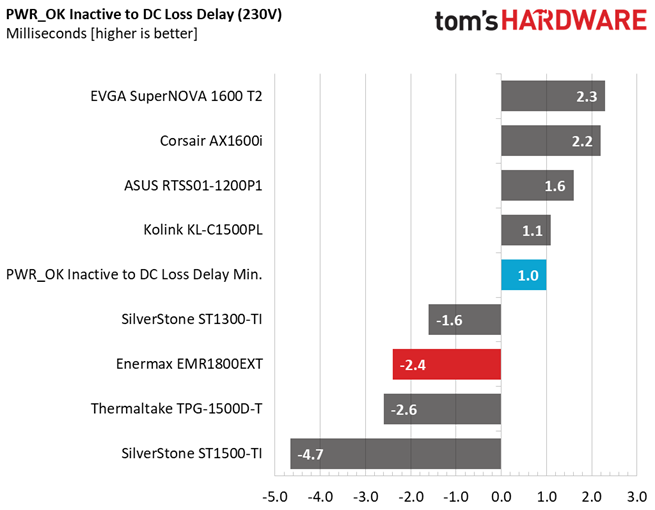
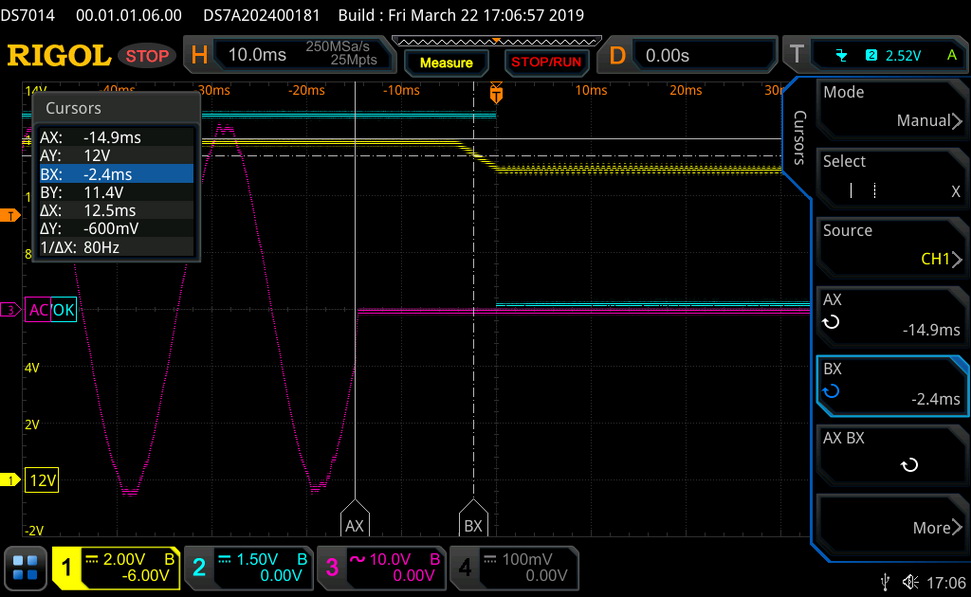
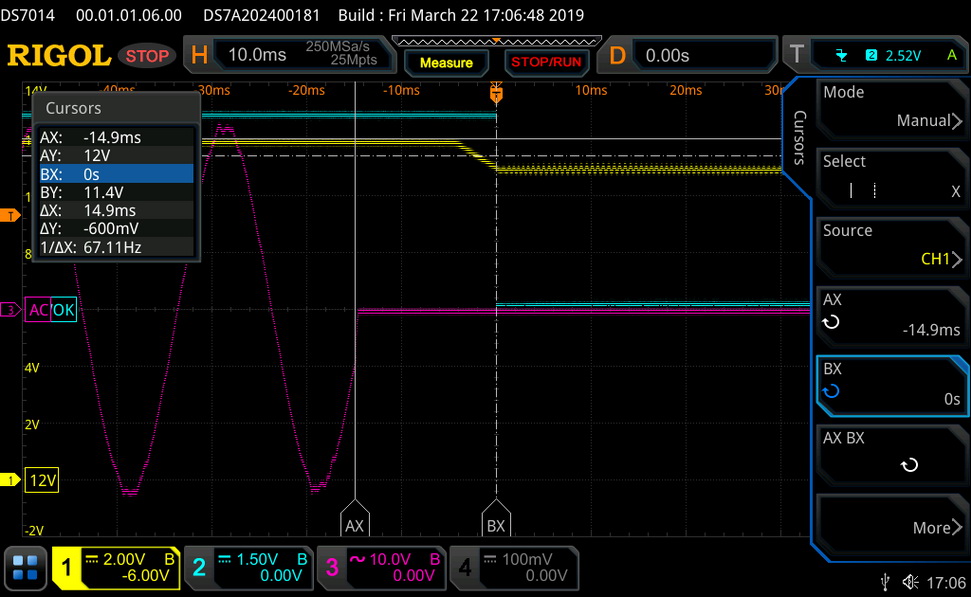
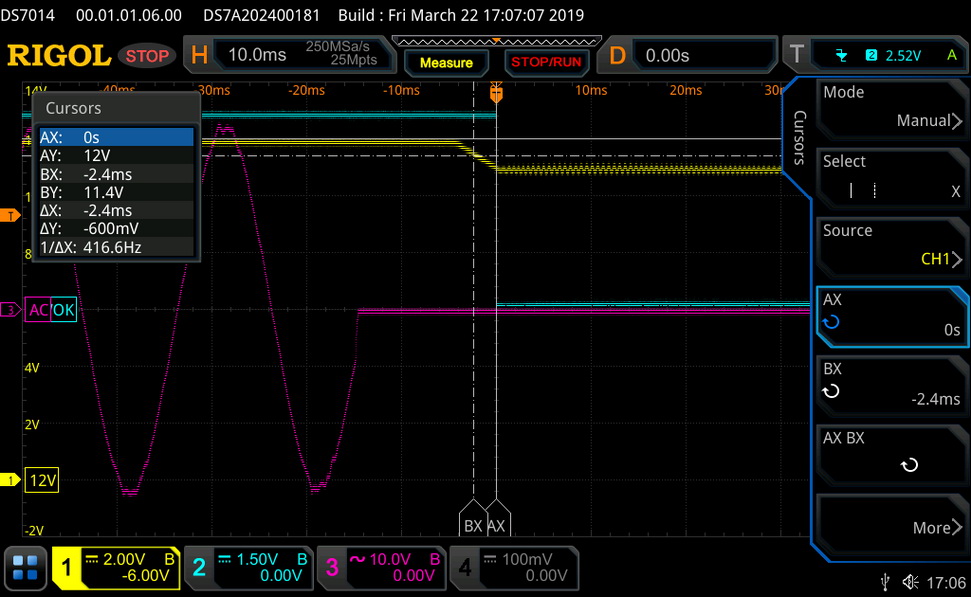
Despite the three bulk caps, the hold-up time is low. To make matters worse, we find an inaccurate power-ok signal which is bad news for such an expensive power supply.
Inrush Current
Inrush current, or switch-on surge, refers to the maximum, instantaneous input current drawn by an electrical device when it is first turned on. A large enough inrush current can cause circuit breakers and fuses to trip. It can also damage switches, relays, and bridge rectifiers. As a result, the lower the inrush current of a PSU right as it is turned on, the better.
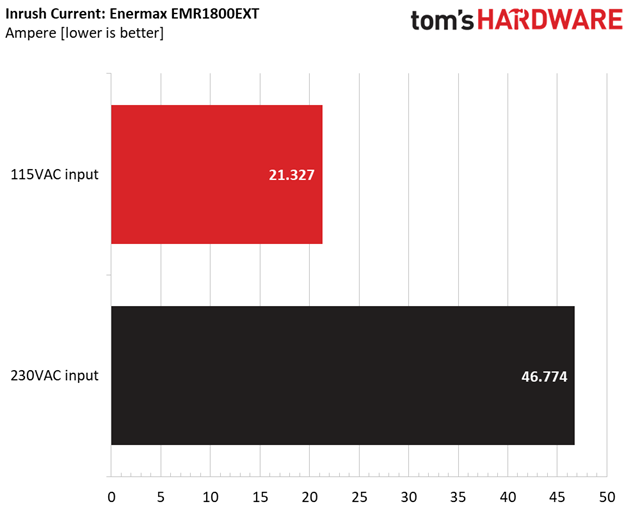

Enermax did a good job here and managed to restrict the inrush currents with both voltage inputs.
Get Tom's Hardware's best news and in-depth reviews, straight to your inbox.
10-110% Load Tests
These tests reveal the load regulation and efficiency levels of the Enermax EMR1800EXT under high ambient temperatures. They also show how the fan speed profile behaves under increased operating temperatures.
| Test # | 12V | 5V | 3.3V | 5VSB | DC/AC (Watts) | Efficiency | Fan Speed (RPM) | PSU Noise (dB[A]) | Temps (In/Out) | PF/AC Volts |
|---|---|---|---|---|---|---|---|---|---|---|
| 1 | 11.352A | 1.963A | 1.948A | 0.981A | 159.946 | 84.363% | 1960 | 42.1 | 40.18°C | 0.994 |
| 12.188V | 5.092V | 3.385V | 5.095V | 189.592 | 42.36°C | 115.10V | ||||
| 2 | 23.744A | 2.950A | 2.926A | 1.181A | 319.665 | 89.318% | 1972 | 42.2 | 40.92°C | 0.998 |
| 12.162V | 5.085V | 3.379V | 5.083V | 357.896 | 43.50°C | 115.11V | ||||
| 3 | 36.517A | 3.446A | 3.408A | 1.381A | 479.207 | 90.561% | 1991 | 42.4 | 41.10°C | 0.999 |
| 12.137V | 5.078V | 3.374V | 5.071V | 529.152 | 44.20°C | 115.11V | ||||
| 4 | 49.416A | 3.943A | 3.916A | 1.581A | 639.667 | 90.762% | 2021 | 43.5 | 41.86°C | 0.999 |
| 12.111V | 5.072V | 3.369V | 5.059V | 704.777 | 45.55°C | 115.11V | ||||
| 5 | 62.007A | 4.937A | 4.907A | 1.784A | 799.857 | 90.411% | 2053 | 44.4 | 42.07°C | 0.999 |
| 12.085V | 5.064V | 3.362V | 5.047V | 884.694 | 46.28°C | 115.12V | ||||
| 6 | 74.649A | 5.934A | 5.900A | 1.987A | 959.928 | 89.814% | 2090 | 44.7 | 42.64°C | 0.999 |
| 12.058V | 5.056V | 3.357V | 5.034V | 1068.797 | 47.86°C | 115.12V | ||||
| 7 | 87.322A | 6.934A | 6.896A | 2.191A | 1119.684 | 89.005% | 2121 | 44.9 | 43.18°C | 0.999 |
| 12.031V | 5.049V | 3.350V | 5.021V | 1258.002 | 49.44°C | 115.12V | ||||
| 8 | 100.116A | 7.937A | 7.896A | 2.397A | 1280.206 | 87.979% | 2170 | 45.4 | 43.80°C | 0.999 |
| 12.004V | 5.041V | 3.343V | 5.009V | 1455.120 | 51.94°C | 115.12V | ||||
| 9 | 113.317A | 8.444A | 8.386A | 2.401A | 1439.578 | 86.778% | 2239 | 45.6 | 44.35°C | 0.999 |
| 11.976V | 5.033V | 3.338V | 4.999V | 1658.928 | 54.03°C | 115.14V | ||||
| 10 | 125.985A | 8.956A | 8.911A | 4.038A | 1599.856 | 85.361% | 2307 | 46.5 | 45.25°C | 0.999 |
| 11.947V | 5.025V | 3.333V | 4.955V | 1874.232 | 55.66°C | 115.15V | ||||
| 11 | 139.724A | 8.968A | 8.923A | 4.045A | 1759.943 | 83.818% | 2393 | 47.8 | 46.67°C | 0.999 |
| 11.918V | 5.018V | 3.329V | 4.946V | 2099.720 | 58.05°C | 115.14V | ||||
| CL1 | 0.157A | 17.001A | 16.998A | 0.000A | 144.981 | 79.019% | 2109 | 44.8 | 42.22°C | 0.994 |
| 12.170V | 5.069V | 3.347V | 5.100V | 183.476 | 46.60°C | 115.15V | ||||
| CL2 | 133.357A | 1.003A | 1.000A | 1.000A | 1608.243 | 85.593% | 2306 | 46.5 | 45.56°C | 0.999 |
| 11.959V | 5.035V | 3.353V | 5.024V | 1878.947 | 55.65°C | 115.14V |
What makes an impression is the very high Power Factor (PF) readings, even under very loads. The interleaved PFC works well. On the other hand, the fan profile is a disaster since, even with 160W load, the fan's speed is close to 2000 RPM.
With 115V input and a 4kVA AC source we managed to go up to 1760W of load. With a normal AC socket that can deliver up to 15A, you will have a problem even with full load (1600W), since in our tests the PSU asked for 1875W from the AC source and the maximum that a wall socket can deliver is 1725W, with 115V output, given that there are no voltage drops which is of course a highly unrealistic scenario.
20-80W Load Tests
In the following tests, we measure efficiency at loads significantly lower than 10 percent of its maximum capacity (the lowest load the 80 PLUS standard measures). This is important for representing when a PC is idle, with power-saving features turned on.
| Test # | 12V | 5V | 3.3V | 5VSB | DC/AC (Watts) | Efficiency | Fan Speed (RPM) | PSU Noise (dB[A]) | PF/AC Volts |
|---|---|---|---|---|---|---|---|---|---|
| 1 | 1.186A | 0.489A | 0.470A | 0.195A | 19.565 | 45.347% | 1945 | 42.0 | 0.935 |
| 12.210V | 5.097V | 3.391V | 5.118V | 43.145 | 115.12V | ||||
| 2 | 2.425A | 0.980A | 0.971A | 0.391A | 39.887 | 61.926% | 1939 | 42.0 | 0.961 |
| 12.207V | 5.097V | 3.389V | 5.113V | 64.411 | 115.11V | ||||
| 3 | 3.598A | 1.472A | 1.445A | 0.587A | 59.306 | 70.587% | 1942 | 42.0 | 0.976 |
| 12.204V | 5.096V | 3.388V | 5.108V | 84.018 | 115.11V | ||||
| 4 | 4.847A | 1.963A | 1.947A | 0.784A | 79.727 | 75.434% | 1953 | 42.1 | 0.979 |
| 12.200V | 5.094V | 3.386V | 5.103V | 105.691 | 115.11V |
Even with light loads the PSU's fan is spinning at high speeds, making a hell of a noise.
Efficiency
Next, we plotted a chart showing the efficiency levels at low loads, and loads from 10 to 110 percent of its maximum-rated capacity. The higher a PSU’s efficiency the less energy goes wasted leading to a reduced carbon footprint, besides lower electricity bills.
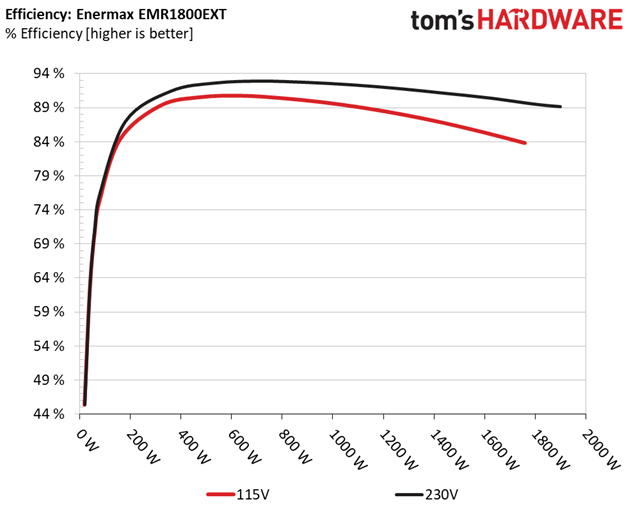



The efficiency results cannot match those from competitors with much more efficient platforms. Especially with light loads, the numbers are disappointing.
5VSB Efficiency
| Test # | 5VSB | DC/AC (Watts) | Efficiency | PF/AC Volts |
|---|---|---|---|---|
| 1 | 0.100A | 0.512 | 71.910% | 0.110 |
| 5.122V | 0.712 | 115.08V | ||
| 2 | 0.250A | 1.280 | 77.954% | 0.220 |
| 5.120V | 1.642 | 115.08V | ||
| 3 | 0.550A | 2.813 | 80.348% | 0.340 |
| 5.114V | 3.501 | 115.08V | ||
| 4 | 1.000A | 5.106 | 80.270% | 0.418 |
| 5.106V | 6.361 | 115.08V | ||
| 5 | 1.500A | 7.646 | 79.737% | 0.459 |
| 5.096V | 9.589 | 115.08V | ||
| 6 | 4.000A | 20.186 | 78.231% | 0.528 |
| 5.047V | 25.803 | 115.08V |
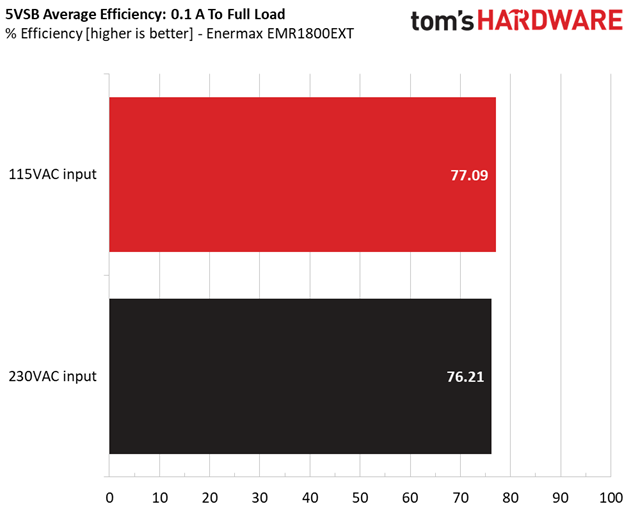

The 5VSB rail besides being powerful, also achieves high efficiency levels.
Power Consumption In Idle And Standby
| Mode | 12V | 5V | 3.3V | 5VSB | Watts | PF/AC Volts |
|---|---|---|---|---|---|---|
| Idle | 12.214V | 5.097V | 3.387V | 5.123V | 25.168 | 0.851 |
| 115.1V | ||||||
| Standby | 0.091 | 0.015 | ||||
| 115.1V |
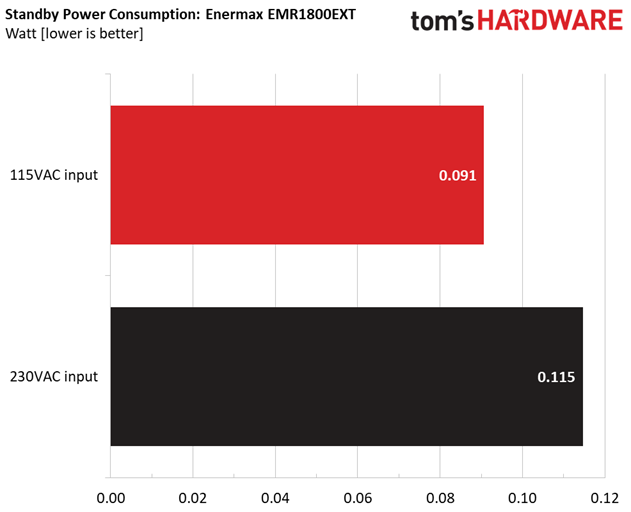
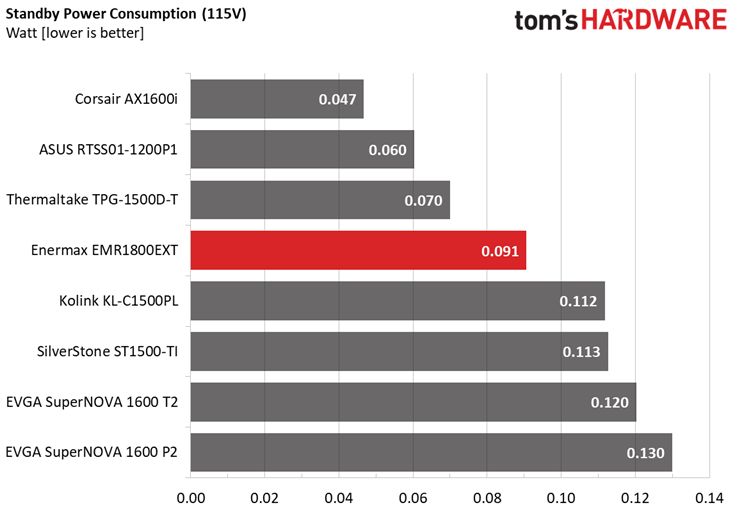
Fan RPM, Delta Temperature, And Output Noise
All results are obtained between an ambient temperature of 37°C (98.6°F) to 47°C (116.6°F).
The fan speed profile could be way better and make the PSU much quieter, especially under light and mid loads.
The following results were obtained at 30°C (86°F) to 32°C (89.6°F) ambient temperature.
From the start, the Enermax EMR1800EXT is in the 40-45 dB(A) region (comparative noise example: library, bird calls), so you should avoid it, at any cost, if you want to build a silent PC system.
MORE: Best Power Supplies
MORE: How We Test Power Supplies
MORE: All Power Supply Content
Current page: Load Regulation, Hold-Up Time, Inrush Current, Efficiency and Noise
Prev Page Specifications and Part Analysis Next Page Protection Features, DC Power Sequencing, Cross-Load Tests and Infrared Images
Aris Mpitziopoulos is a contributing editor at Tom's Hardware, covering PSUs.
